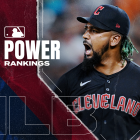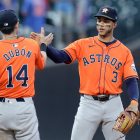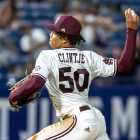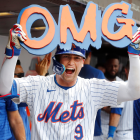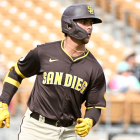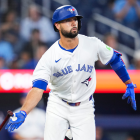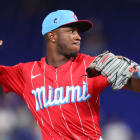There is no sense in sugarcoating it: 2018 was an unmitigated disaster for the Baltimore Orioles. They lost the fifth most games in baseball history, waited at least half-a-season too long to trade Manny Machado, traded Jonathan Schoop and Zack Britton when their value was down, and watched several players take steps back on the field. It was a colossal failure of a season.
"We're going to do everything in our power to move things in the right direction," said new general manager Mike Elias during his introductory press conference in November. "We're not going to be perfect with our decision-making. Nobody is. But we're going to add talent in every direction until the wins pile up."
Not surprisingly, the Orioles had a relatively quite offseason, one that focused more on organizational changes than roster additions. They made some (very) low-cost free additions, a few waiver claims, and a pair of Rule 5 Draft picks. That's about it. Another rough season is in the cards in 2019, but at least now the O's have some direction. Let's preview their 2019 season.
- 2018 record: 47-115 (negative-270 run differential)
- 2019 depth chart: Click here
- 2019 schedule: Click here
Probable lineup
- CF Cedric Mullins
- 2B Jonathan Villar
- DH Mark Trumbo
- 1B Chris Davis
- LF Trey Mancini
- 3B Rio Ruiz
- RF Joey Rickard
- C Chance Sisco
- SS Richie Martin
Bench: C Austin Wynns, IF Hanser Alberto, UTIL Renato Nunez, UTIL Drew Jackson
Needless to say, very little is set in stone here. Mullins, Villar, and Mancini are safe bets to play every day and that's about it. The right-handed hitting Nunez will likely see platoon duty with the lefty hitting Ruiz and Davis, and he could see some outfield time as well. Jackson, a Rule 5 Draft pick like Martin, a potential super utility type who could see time all over the infield and outfield.
Young outfielders Austin Hays, Anthony Santander, and DJ Stewart have already been reassigned to minor league camp, so they won't be on the Opening Day roster. Expect all three to spend time in Charm City this summer though. Rickard's just keeping the seat warm.
Probable rotation
- RHP Alex Cobb
- RHP Dylan Bundy
- RHP Andrew Cashner
- RHP David Hess
- RHP Mike Wright Jr.
With Opening Day less than a week away, the fourth and fifth rotation spots remain up for grabs. Veteran righty Nate Karns and rookie southpaw Josh Rogers are still in the mix. No matter the Opening Day rotation, the Orioles are going to need all these guys to get through the season, plus more. Yefry Ramirez, Hunter Harvey, and Jimmy Yacabonis are among the depth options. The top three starters are set. Those last two spots figure to be a revolving door all summer.
Probable bullpen
Closer: RHP Mychal Givens
Setup: LHP Richard Bleier, RHP Miguel Castro
Middle: RHP Pedro Araujo, LHP Paul Fry, LHP Tanner Scott
Long: RHP Nate Karns
Givens and Bleier give the O's a respectable end-game duo -- Bleier has thrown 96 innings with a 1.97 ERA and a 65.3 percent groundball rate the last two years, making him one of the best kept secrets in baseball -- and that presumably makes them trade chips. Scott is someone to watch. Throwing strikes can be an issue at times, but a 24-year-old lefty who sits in the upper-90s and struck out more than 30 percent of the big-leaguers he faced last season demands attention.
Araujo was a Rule 5 Draft pick last offseason who missed much of 2018 with an elbow injury. He needs to spend 14 days on the O's active big league roster this year to satisfy the Rule 5 Draft rules. Bet on that happening. Once it does, the Orioles will be able to option Araujo to Triple-A without passing him through waivers. Cody Carroll, Branden Kline, Ramirez, and Yacabonis are notable depth relievers who will inevitably be shuttled in and out this summer.
An organizational overhaul
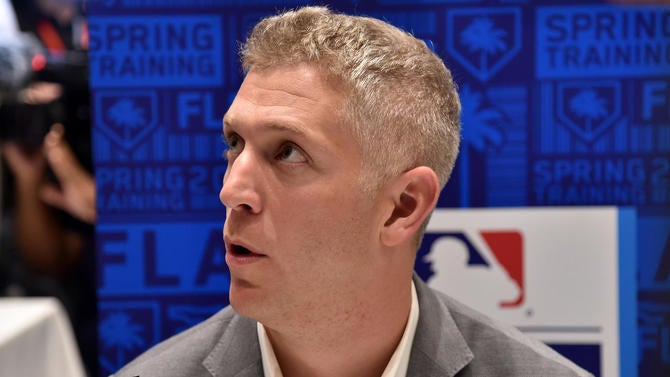
If any good comes from the O's 115-loss 2018 season, it is the drastic changes that were made throughout the organization in response. When you lose that many games, you can't stand pat. You just can't. Longtime manager Buck Showalter and GM Dan Duquette were among those let go. Here are a few of the notable new additions:
- GM Mike Elias (previously an assistant general manager with the Astros)
- Assistant GM Sig Mejdal (previous the Astros' director of decision sciences)
- International scouting director Koby Perez (previously Latin American scouting director with the Indians)
- Manager Brandon Hyde (previously the Cubs bench coach)
"There is exciting potential here," owner representative Lou Angelos said during Elias' introductory press conference. "Mike's deep background in scouting really made quite a difference in the discussions that we had. His success with the Astros, hearing about it in detail, he's been through this."
Under Duquette, the biggest knock against the O's was that they were behind the times analytically. Elias and especially Mejdal will change that. The second biggest knock against them was their international inactivity. They eschewed international prospects and instead traded their allotted bonus pool money for fringe big-leaguers. Perez is going to change that.
The club has also made sweeping changes to their scouting and analytical departments over the winter (i.e. they actually built an analytics department) with many new hires. Simply put, Elias is getting the Orioles out of the Stone Age. Duquette's old school approached worked for several years. Not any longer. It was time for change -- drastic change.
Hyde has no full-time MLB managerial experience -- he did manage one game with the Marlins on an interim basis when Edwin Rodriguez abruptly resigned in 2011 -- but he has extensive coaching experience, and he did manage in the minors. He is well-versed in analytics and encourages a looser atmosphere, which is pretty much the polar opposite of his predecessor.
"When you've been a minor-league coach, and you've been on Field 76 in the back, and it's 97 degrees out, and there's no music, I know what that feels like," Hyde said to the Associated Press earlier this month. "... I want guys to play free and easy. I want guys to showcase their talent. They're in big league camp, so prove to everybody that you're a big league player and not feel restricted in any way."
Elias, Mejdal, Perez, and Hyde have a lot of work ahead of them. A lot. The good news is they are getting what amounts to a clean slate organizationally, and there's really nowhere a team can go but up after losing 115 games. The O's took the steps necessary to become a state-of-the-art MLB outfit over the winter. Now they have to patient and wait for the results to follow.
Is Chris Davis salvageable?
The contract was ill-advised from the start and it has only looks worse with each passing year. In 2018, year three of his seven-year contract worth $161 million, Chris Davis hit .168/.243/.296 (50 OPS+) with 16 home runs in 522 plate appearances. He was understandably benched for long stretches of time but still managed to post an MLB-worst negative-2.8 WAR. There have been 61,502 individual position player seasons in MLB history. Davis' was 17th worst by WAR. Yeesh.
Davis turned 33 earlier this week and he's owed $92 million the next four years. It's a sunk cost. The Orioles can forget trading Davis for anything of value, and that includes saving even a little cash. This is a deal they'll have to live with. Davis has always struck out a ton, but, in the past, the strikeouts came with immense power. His ability to hit the ball hard has dried up though. Some 2018 Statcast ranks:
- Exit velocity: 88.9 mph (54th percentile)
- Hard-hit rate: 39.0 percent (60th percentile)
- Expected batting average: .190 (0th percentile!)
- Expected slugging percentage: .356 (18th percentile)
Once one of the most feared sluggers in the game, Davis has been reduced to hitting the ball like a defense-first backup catcher. He's not drawing as many walks either because why would pitchers be afraid to challenge him? Davis has always been a flawed hitter. Never before has he been this flawed.
The Orioles have two options at this point. One, they could keep running Davis out there and hope he figures something out, and provides some return on that contract. Things aren't looking promising but hey, maybe something clicks, and Davis goes back to socking dingers. Also, Davis is regarded as a good clubhouse guy, which is not nothing for a young team.
Or two, the Orioles could eat the $92 million and release him, which would allow them to move Mancini back to his natural first base position. We've seen several teams eat big money and multiple years to release players these last few seasons. Troy Tulowitzki, Jose Reyes, Pablo Sandoval, and Carl Crawford were all released with at least two years and $35 million remaining on their contracts. Davis still has $92 million -- $92 million! -- coming his way though.
If there were one or two years remaining on his contract, I think releasing Davis would be a serious consideration for the O's. With four years though, I think they're going to ride it out in 2019, and hope Davis figures some things out. He's not really blocking anyone right now, and he's not so old that hoping for a rebound is unreasonable. That said, things are not looking good for Davis. This is the worst contract in baseball.
What would qualify as a successful season?

Success is defined in different ways for different teams. For the AL East rival Yankees and Red Sox, anything short of winning the World Series would be a disappointment. For the Rays, getting to October would be a success.
For the Orioles? Well, that's a little tougher to define, because clearly they are not contending, and so much of what needs to improve will happen behind the scenes in the front office. You can't always see improved decision-making and scouting and analytics, at least not so quickly.
Success can be measured incrementally though, and the more of the following that happens, the more successful the season will be for the Orioles:
- Young big-leaguers like Mullins, Sisco, Hess, and Scott establish themselves as building blocks.
- The new front office helps Bundy rediscover the promise that made him the No. 4 pick in the draft.
- Top prospect Yusniel Diaz carries last year's Double-A success up to Triple-A this year.
- Austin Hays and Hunter Harvey overcome their injury issues to recapture top prospect status.
- Rule 5 Draft picks Richie Martin and Drew Jackson prove themselves to be solid role players.
- Midseason trades (Givens? Bleier? Cobb? Cashner? Villar?) bring more talent to the organization.
The Orioles also hold the No. 1 pick in the 2019 draft, and while there is no clear-cut No. 1 generational type of talent like Bryce Harper in this year's draft, Oregon State catcher Adley Rutschman is an absolute stud. He's a switch-hitting, middle-of-the-order force and a very good defender. Rutschman is probably the best catcher to come out of the college ranks since Buster Posey, and he will be there for the taking for the O's on draft day.
At a minimum, the Orioles look to be three years away from contention. It could be more like five or six years. At least now they have a bright new front office and aren't behind analytically. The farm system lacks a future star like Vladimir Guerrero Jr. or Fernando Tatis Jr., but there is talent in there, and guys like Mullins and Diaz could be lineup staples very soon. Hays, Harvey, and Dillon Tate (former No. 4 pick and part of the Britton trade) offer nice bounceback potential and high ceilings.
A successful 2019 season for the Orioles would include young big-leaguers solidifying themselves as long-term pieces, prospects either increasing their value or rebuilding their value, and the front office unearthing hidden gems. Elias and Mejdal helped find Marwin Gonzalez and Collin McHugh while with the Astros. The O's need to find some guys like that for themselves. There is a long way to go between now and contention, but at least now the organizational arrow seems to be pointing up.










